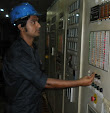ENGINE COOLING WATER PREHEATER
The key reason for using an engine cooling water preheater is to
maintain the engine at a temperature to ensure it starts quickly when required.
Cold engines can take a considerable time to crank up during which time the
starter batteries or high pressure starting air will be heavily discharged.
However apart from a starting aid, the heaters provide the following additional
benefits:
Reduces
engine wear - Engine
wear can be reduced by up to 50%. The lubricating oil is also kept warm and
thus ensures that the essential oil is immediately pumped to the critical
moving parts and points of the engine during the start cycle.
Saves fuel
- It is not necessary to leave engines
idling to maintain them above the required starting temperature.
Reduced
exhaust emissions on start - Engines are designed to emit lower emissions at their
operational temperature.
Less stress
on other components - Batteries when cold have a reduced ampere hour
capacity and starting a cold engine can put a considerable drain on a battery
system.
Avoids the
risk of water condensation in the engine sump - An engine system left for a length of time in cold temperatures
will see an increase in water build up due to condensation. Keeping the engine
warmer than the surrounding ambient significantly reduces condensation.
Preheating System:
The
preheater and circulating pump are placed in parallel with the jacket water
main pumps, and the water flow direction is the same as for the jacket cooling
water system. The preheater operation is controlled by a temperature sensor
after the preheater.
 |
| Fig: Engine Preheating System |
The
preheating pump take suction from just before the main HT water pump and
deliver after HT water pump (Just before Engine in). At heat exchanger water
can be heated by electric heater or steam. Some components such as- valve, strainer,
temperature controller, temperature and pressure gauge also installed.
 |
| Fig: Preheater Unit |
 |
| Fig: Preheater Unit |
Preheater capacity:
When
a preheater is installed in the jacket cooling water system, the preheater pump
capacity, should be about 10% of the jacket water main pump capacity. It is
recommended that the pressure drop across the preheater should be approx. 0.2
bar. The preheater pump and the jacket water main pump should be electrically
interlocked to avoid the risk of simultaneous operation.
The
preheater capacity depends on the required preheating time and the required
temperature increase of the engine jacket water. The temperature and time
relationship is shown in Figure abobe. The relationship is almost the same for
all engine types.
VISITORS ZONE
|
Q:What should be properties of hydraulic oil?
How a pneumatic jack differ from strand jack?
Please put your answer in comment section for discussion










Hi, Really great effort. Everyone must read this article. Thanks for sharing.
ReplyDeleteI find it fascinating how preheating systems can contribute to fuel savings and reduced emissions.
ReplyDeletebiinyuu568ds
ReplyDeletegolden goose outlet
golden goose outlet
golden goose outlet
golden goose outlet
golden goose outlet
golden goose outlet
golden goose outlet
golden goose outlet
golden goose outlet
golden goose outlet